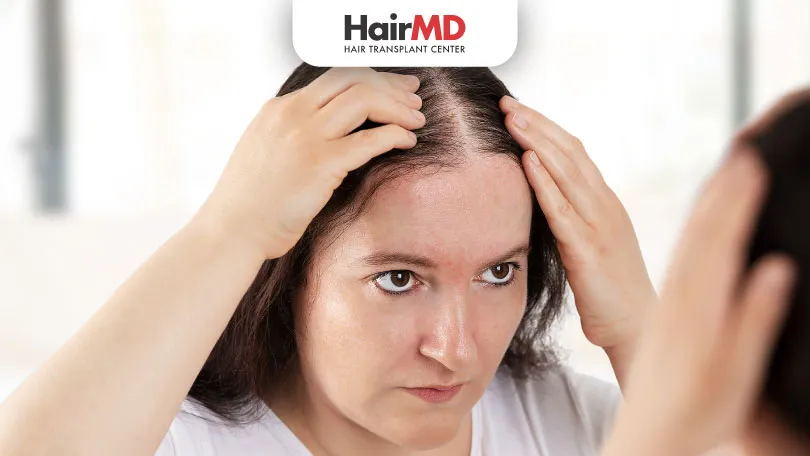
Is your scalp partition widening and is making you worried about hair loss? Hair shedding is a common phenomenon in women, which means sighting hair strands on the floor, brush, and pillow are common amongst all. The normal hair loss per day for females ranges between 50-100 strands. If you observe more than 125 hair strands falling, bald patches, or thinning of hair, this may signify hair loss.
Shedding of hair is part of the normal hair cycle; the cycle involves the shedding of hair and then regrowth. However, if the hairs are falling out but there is no regrowth, it is called hair loss. When hair loss happens, there is no hair regrowth, and this ineptitude makes it different from hair fall or shedding.
What’s covered in the article?
- What is the Hair Growth Cycle?
- Types of Hair Loss in Women
- What Causes Hair Loss in Women?
- Conclusion
What is the Hair Growth Cycle?
The cycle of hair growth consists of three phases.
Anagen (Growing Phase)
This phase is also called the growing phase, where 80-90% of the hair are thick and strong, allowing the hair to grow long. This phase can be anywhere between 2-8 years.
Catagen (Resting Phase)
This phase is also called the resting phase. The hair follicles have finished growing and display no growth or shrinkage. 5 to 10% of the hair on the scalp are always in a catagen phase at all times. This period lasts for two to three weeks when the hair follicles start shrinking.
Telogen (Falling Phase)
The hair root shrinks, and the hair strand stops moving. Old hair begins to fall out, and new anagen hair starts growing below it. This period can be as long as three to four months, and by the end of the period, the hair have fallen out and new anagen hair starts growing in those follicles.
Types of Hair Loss in Women
There are three types of hair loss in women. These types of hair loss are different from daily hair loss as they do not facilitate regrowth.
Telogen Effluvium
This type of hair loss is caused due to a lot of hair follicles suddenly going into the telogen or falling phase of the hair growth cycle. The normal shedding percentage changes from 10-15% to 20-25%, making a lot of hair fall out. This sudden change can be due to underlying factors such as illness, chronic stress, sudden weight loss etc.
Female Pattern Hair Loss (FPHL)
This type of hair loss is commonly seen in females. The hair loss is due to the thinning of hair from both sides and head
Anagen Effluvium
This type of hair loss can be caused by chemotherapy treatments that affect the hair follicle adversely.
What Causes Hair Loss in Women?
If you are losing more than 50-100 strands a day and see no hair regrowth, you are likely suffering from hair loss. There are many reasons behind hair loss, including:
Genes- Progressive thinning and familial hair loss due to hereditary and genes are the most common cause of hair loss.
Hormonal Changes- Hormonal changes due to menopause, birth control pills or pregnancy also causes hair loss.
Improper Diet- Deficiency of vitamins and improper diet can make your hair weak and fall out.
Stress- Physical and mental stress like abrupt weight loss, giving birth, chronic illness, loss of a family member etc., can cause hair to fall out.
Hairstyle- Braids and high ponytails can pull your hair and result in hair loss.
Medications- Medications prescribed within various treatments can damage the hair growth cycle resulting in hair loss
Ageing and Menopause- Ageing and hormonal shift during menopause can trigger hair loss.
If you have more than normal hair loss per day as a female, you must visit a dermatologist to start the treatment immediately. The doctor can easily differentiate between hair loss and normal shedding with the help of dermatological tests. Visit a dermatologist today and start the treatment without delay.
DO YOU KNOW?
Nearly 250 Patients Visit HairMD
Everyday For Various Hair Concerns
(15+ Years Of Expertise. 4157+ Successful Hair Transplant)
Meet Our Dermatologists
Conclusion
In conclusion, hair loss in women can happen for many reasons, including genetics, hormonal changes, stress, and more. It’s important to understand the difference between normal hair shedding and hair loss, which stops hair from growing back.
If you’re noticing more hair falling out than usual, or seeing thinning and bald patches, it’s a good idea to consult a dermatologist at HairMD Pune right away. Early treatment can help manage and even reverse hair loss. Don’t wait—take action now for healthier hair!
Further Reading
Top Hair Growth Treatments for Women: Your Ultimate Guide
Find effective hair regrowth treatments for women. Explore solutions like PRP, medications, and more to combat hair loss with expert advice from HairMD.
Relation Between Masturbation and Hair Loss
Is there a relation between masturbation & hair loss? Uncover truth with our detailed analysis, separating fact from fiction to provide clarity on this common concern.
Biotin for Hair: Effective or Overrated? | HairMD Pune
Biotin is popular for hair growth, but does it really work? Find out what HairMD Pune experts reveal about its benefits and limitations.
Is Male Pattern Baldness Dominant or Recessive?
Male pattern baldness is not simply dominant or recessive. Learn the genetics, myths, and treatments available at HairMD Pune.
Have thoughts? Please let us know
We are committed not only to treating you, but also educating you.










